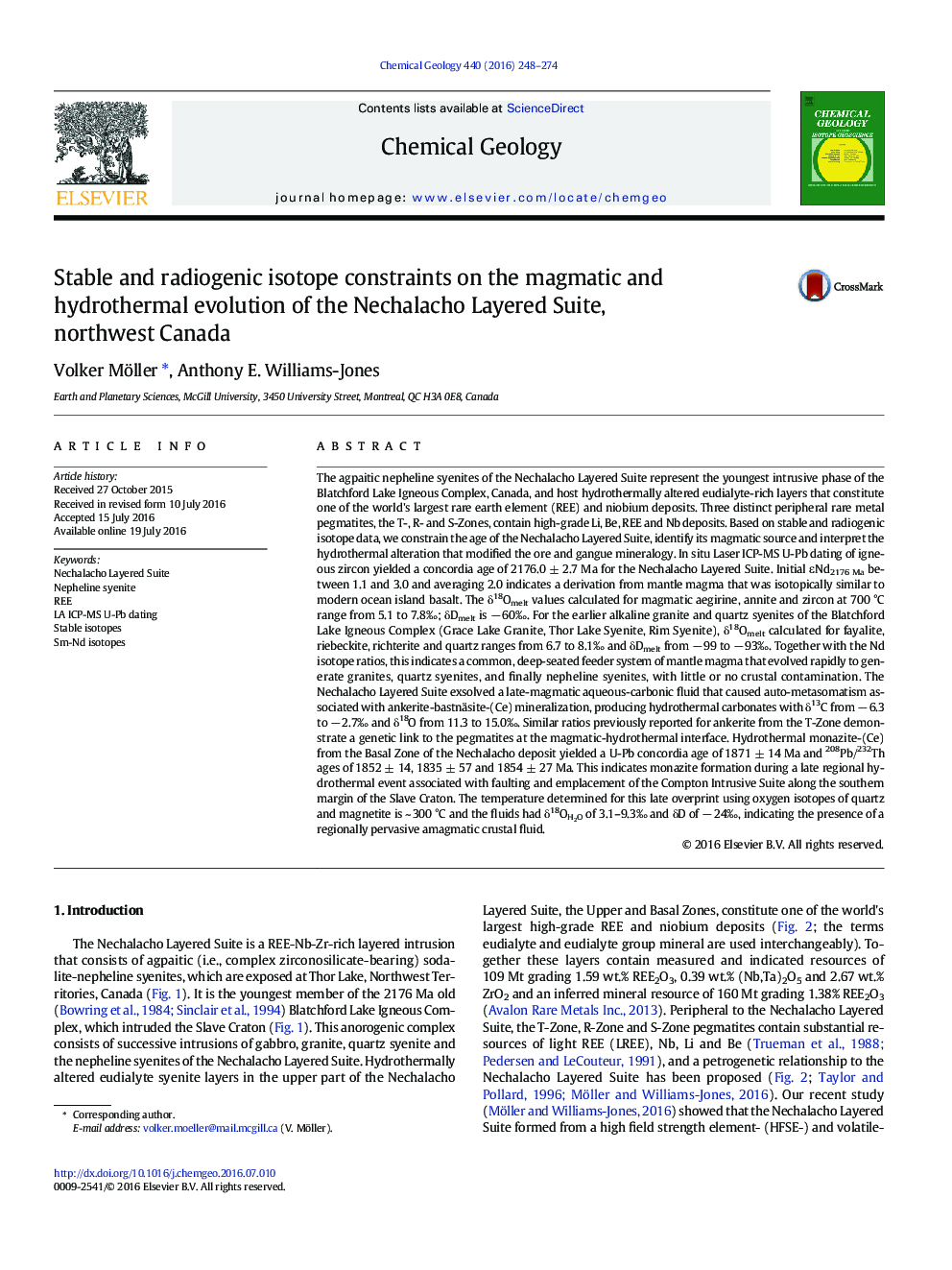| کد مقاله | کد نشریه | سال انتشار | مقاله انگلیسی | نسخه تمام متن |
|---|---|---|---|---|
| 6436041 | 1637534 | 2016 | 27 صفحه PDF | دانلود رایگان |

- We present isotope data for the Nechalacho Layered Suite (NLS), Thor Lake, that hosts one of the world's largest REE deposits.
- The age of the NLS was determined at 2176.0 ± 2.7 Ma (Laser ICP-MS U-Pb zircon concordia).
- εNd2176 Ma averaging 2.0, δ18Omelt = 5.1-7.8â° and δDmelt = â 60â° show that the NLS was derived from OIB-like mantle magma.
- δ13C and δ18O of hydrothermal carbonates in the NLS track auto-metasomatism by late-magmatic carbonic hydrothermal fluids.
- Dating of hydrothermal monazite from the Basal Zone indicates a 1835-1871Â Ma regional overprint of the rare metal deposits.
The agpaitic nepheline syenites of the Nechalacho Layered Suite represent the youngest intrusive phase of the Blatchford Lake Igneous Complex, Canada, and host hydrothermally altered eudialyte-rich layers that constitute one of the world's largest rare earth element (REE) and niobium deposits. Three distinct peripheral rare metal pegmatites, the T-, R- and S-Zones, contain high-grade Li, Be, REE and Nb deposits. Based on stable and radiogenic isotope data, we constrain the age of the Nechalacho Layered Suite, identify its magmatic source and interpret the hydrothermal alteration that modified the ore and gangue mineralogy. In situ Laser ICP-MS U-Pb dating of igneous zircon yielded a concordia age of 2176.0 ± 2.7 Ma for the Nechalacho Layered Suite. Initial εNd2176 Ma between 1.1 and 3.0 and averaging 2.0 indicates a derivation from mantle magma that was isotopically similar to modern ocean island basalt. The δ18Omelt values calculated for magmatic aegirine, annite and zircon at 700 °C range from 5.1 to 7.8â°; δDmelt is â 60â°. For the earlier alkaline granite and quartz syenites of the Blatchford Lake Igneous Complex (Grace Lake Granite, Thor Lake Syenite, Rim Syenite), δ18Omelt calculated for fayalite, riebeckite, richterite and quartz ranges from 6.7 to 8.1â° and δDmelt from â 99 to â 93â°. Together with the Nd isotope ratios, this indicates a common, deep-seated feeder system of mantle magma that evolved rapidly to generate granites, quartz syenites, and finally nepheline syenites, with little or no crustal contamination. The Nechalacho Layered Suite exsolved a late-magmatic aqueous-carbonic fluid that caused auto-metasomatism associated with ankerite-bastnäsite-(Ce) mineralization, producing hydrothermal carbonates with δ13C from â 6.3 to â 2.7â° and δ18O from 11.3 to 15.0â°. Similar ratios previously reported for ankerite from the T-Zone demonstrate a genetic link to the pegmatites at the magmatic-hydrothermal interface. Hydrothermal monazite-(Ce) from the Basal Zone of the Nechalacho deposit yielded a U-Pb concordia age of 1871 ± 14 Ma and 208Pb/232Th ages of 1852 ± 14, 1835 ± 57 and 1854 ± 27 Ma. This indicates monazite formation during a late regional hydrothermal event associated with faulting and emplacement of the Compton Intrusive Suite along the southern margin of the Slave Craton. The temperature determined for this late overprint using oxygen isotopes of quartz and magnetite is ~ 300 °C and the fluids had δ18OH2O of 3.1-9.3â° and δD of â 24â°, indicating the presence of a regionally pervasive amagmatic crustal fluid.
Journal: Chemical Geology - Volume 440, 15 November 2016, Pages 248-274